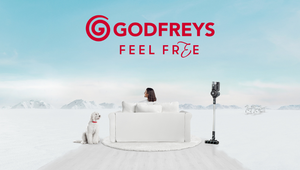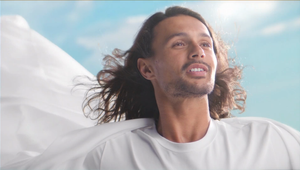
Seeing Double-Blind: How A Unique Creative Experiment Came to Life

It’s a simple enough starting point - what happens when a team of creatives collaborate on a film with no storyboard, no concept art and no script? Working independently to produce unique VFX shots, a group of artists, designers and creatives stitched their disparate work together to create a film.
Following that, the finished shots were handed over to an editor and a sound designer. They also took a totally open-minded approach to the project, and the finished product that came out of their work was the first Double-Blind. You can watch that film below:
That was 2015, and the project exploded. Sweeping award and film shows from Brisbane to Budapest via LA, the experiment also picked up a Vimeo staff pick.
Fast forward to today, and a team of fifteen artists and three sound designers have collaborated on a sequel, ‘Annuli - Double-Blind No.2’.
To go behind the scenes of this unique project, LBB’s Adam Bennett spoke to VFX artist Matt Crump, motion designer Victor Bandeira and creative director Zenon Kohler.
Matt Crump - VFX Artist at Cutting Edge
Contribution runs 0:01:15 - 0:01:21
LBB> Why was this something that you wanted to be involved with?
Matt> This project is definitely a bit off the wall in terms of approach - it's very experimental, and so it was exciting to be apart of something in which none of us really knew how it would turn out once combined.
LBB> This is such a unique project - in what ways has your creative process differed compared to other projects you've worked on?
Matt>The process was unique in the sense that we were each working in solitude on a rather abstract snippet of sound, without the foresight of rigid continuity. There was a lot of intrigue and sneaky peeking over each other's shoulders. It was fun.
LBB> What were the most challenging components and how did you deal with them?
Matt> The hardest part for me was definitely deciding on a concept from a single snippet of sound! There was initially a lot of overthinking it until eventually I decided I wanted to create a feathered creature. I quickly arrived at some kind of micro life cycle, which was a surprise even to myself to be honest!
Victor Bandeira - Motion Designer at Cutting Edge
Contribution runs 0:01:05 - 0:01:11
LBB> Why was this something that you wanted to be involved with?
Victor> I loved the first one and when the idea of this second one was presented to me, I instantly wanted to work on it. Firstly, 'cuz I would have total freedom to create something, and secondly, because I knew it would be a very short piece, so I would be able to pay a lot of attention to details.
LBB> This is such a unique project - in what ways has your creative process differed compared to other projects you've worked on?
Victor> I think I wasn't inspired by the sound in an abstract form like everybody else, so I tried to create something that would give the impression to anyone watching it that my animation was actually creating the sound.
LBB> What were the most challenging components and how did you deal with them?
Victor> Definitely creating this DJ routine of pressing buttons and rotating knobs that would be in sync with my audio and still look cool from an animation perspective.
Zenon Kohler - Creative Director / Cutting Edge
LBB> First of all, how does a project like this begin to come about?!
Zenon> The Double-Blind Experiments are a creative outlet for the team. We wanted to see what happened when we freed ourselves of a client brief and followed our instincts. Following the unexpected success of the first Double-Blind experiment, we were excited to continue the creative exploration of the unknown. We assembled an expanded team of very talented people and got to work.
The original Double-Blind Experiments team consisted of five artists, all work colleagues at Cutting Edge. They formulated a design experiment with no script, no storyboards and no concept art.
We second experiment was a chance to do things differently. We recruited 15 artists, and instead of starting with footage we began with a bed of sound that broken into short audio clips. Artists took inspiration from the sound, and started to explore once more.
LBB> Why was this something that you wanted to be involved with?
Zenon> The opportunity to create motion design and VFX shots with total creative freedom is an attractive prospect to most artists in our industry, although starting with essentially no concept can be daunting. However, once inspiration strikes, the process of creating something personal with only yourself as the client is hugely satisfying. So having miscellaneous plate shots on hand, and three months to sift through them for inspiration; I had more ideas than time so had to choose which ones I wanted to work up. I personally believe if you create something that makes you cringe when people view it, it’s not good enough, so it was important that I was happy with every shot I produced.
LBB> Going all the way back to the first project - in all honesty, did you always expect it to be as well-received as it was?
Zenon> Not at all. We’d hoped it would get noticed, expected maybe a few comments on Vimeo, maybe a share or two, but didn’t expect such a positive response. Once it received a Vimeo Staff Pick, the views rapidly increased. Before we knew it, enquiries began flooding in for interviews and breakdowns, hence the production of the case-study.
The first screening request came from Down The Rabbit Hole music festival in The Netherlands. They wanted to show it at the end of each day, with a collection of other experimental films, in a giant whale-shaped theatrette… I kid you not.
This inspired us to begin entering it in film festivals and over the following two years it screened at over 60 festivals all over the world, picking up over 20 awards in a multitude of categories.
Not bad for a design experiment that was intended as a creative outlet.
LBB> Why was now the right time to revisit the idea with this second project?
Zenon> We knew it was the right time for another experiment because we as a group we had been doing some other exciting creative work. We ran a charity art auction with bowling pins called CEX, and we had just recently completed VFX and footage for a series of wild sci-fi music videos for Alice in Chains. We wanted to keep the good times rollin’.
We always knew we wanted to do another Double-Blind experiment but didn’t want to follow exactly the same formula. As motion designers we’re often required to create with nothing but a script or voice-over so yet again, the daunting blank canvas comes into play. However, we’re always up for a challenge.
So second time around we decided to begin with sound only. The sound designers at Cutting Edge created a bed of eclectic sound and composition. Next this was cut into clips of varying lengths before being randomly distributed to the artists.
For the artists, this experiment consisted of only two rules:
1. Take inspiration from the randomly supplied sound clip.
2. Create a visual representation of this sound, beginning and ending with a circle of a predetermined size… fill the space between two circles.
In mathematics, the annulus is the area between two concentric circles. “Annuli”, the title of Double-Blind No.2, describes the space between multiple circles, in this instance, on a timeline, not in physical space.
Even though we weren’t replicating the experiment, due to the success of the first experiment, in “Annuli” we decided to retain a couple of the original elements as a visual cue to “Double-Blind No.1”. Bookending the design experiment, a quick shoot of the bikini model and one of the hazmat guys set the scene for the next episode.
LBB> Where did you shoot, and why?
Zenon> The first experiment was shot in an abandoned warehouse situated across the road from Cutting Edge. It has since been demolished and replaced with an apartment block. The second experiment was shot in the Cutting Edge loading dock.
We were looking for a nondescript background that could double as a hidden bunker or test facility - somewhere you would expect an underground experiment to take place.
LBB> This is such a unique project - in what ways has your creative process differed compared to other projects you've worked on?
Zenon> Normally the projects we work on consist of a client brief and a collaborative creative process. Our Double-Blind experiments encourage artists to find inspiration from places they might not normally look in their day-to-day jobs forcing them to create more personal work. This may be in the form of visual aesthetics or something more introspective.
LBB> What were the most challenging components and how did you deal with them?
Zenon> This kind of open brief appears to prove more challenging than most artists first expect. Creating a visual representation of a supplied sound clip, beginning and ending with a circle of a predetermined size might initially sound like a straight-forward request, especially when the clip is only four seconds long, but the open brief and blank canvas can prove to be a mental hurdle. Once an artist breaks free of the conditioning they are used to from working to a client brief, the result is often some of their best work.











